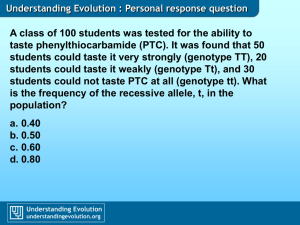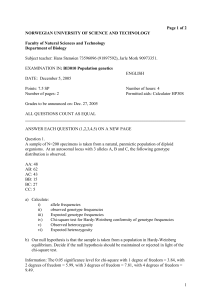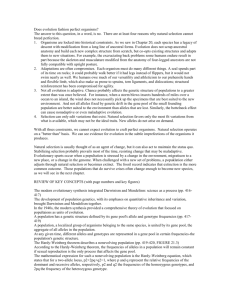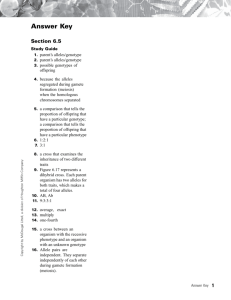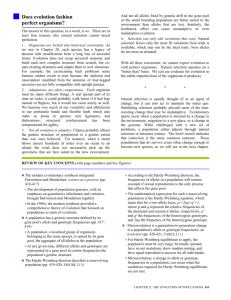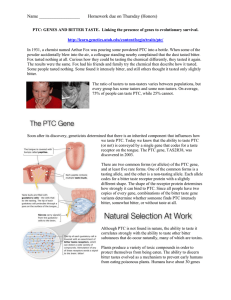Cells Lab
advertisement
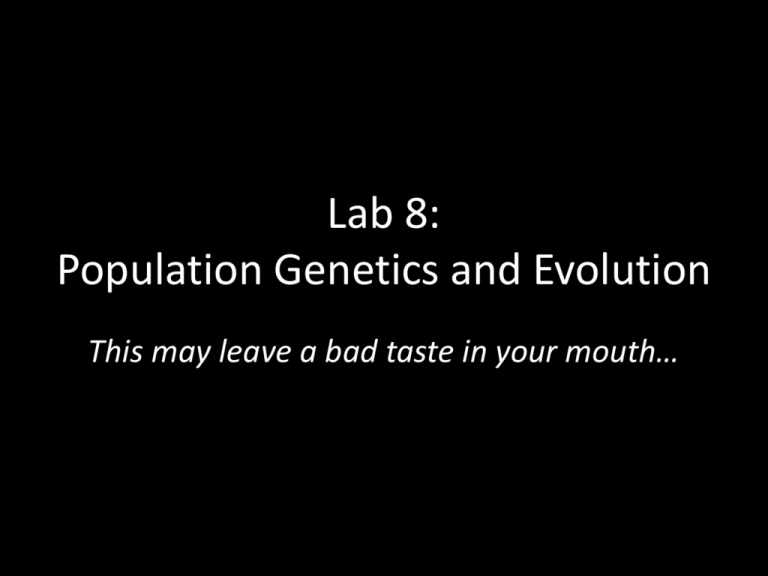
Lab 8: Population Genetics and Evolution This may leave a bad taste in your mouth… Pre-Lab Orientation • Recall that the Hardy-Weinberg Equation helps us identify allele frequencies throughout a population. – Given certain assumptions like “large population size,” “random mating,” et cetera… • A great example for a classroom is ability to taste PTC (phenylthiocarbamide). – This stuff is, oddly, used to grow transparent fish by inhibiting melanin production. PTC • Not everyone can taste PTC. • In North America, 55% of people can taste it (it tastes quite bitter), while 45% cannot. • Which one are you? – Let’s take a taste, shall we? (you don’t have to) • I’m going to wash my hands and give you a small piece. • Place it on the tip of your tongue and wait a few seconds. • If you are a PTC taster, you’ll get a bitter taste. If not, you’ll just taste something papery. – Don’t swallow it. Just awkwardly peel it off your tongue and toss it in the trash. Starting the lab… • Take some time to read the Introduction and Exercise 8A while I’m coming around with PTC. • Once we all taste the PTC strips, we’ll take some classroom data and record it in Table 8.1, then answer the Topics for Discussion on Page 2. – Save Exercise 8B – Case Studies for another time. Exercise 8B • Now we start the Case Studies… • …so I’m sorry if this seems a little forward, but you need to go find a mate. – A random mate – remember this is simulating HardyWeinberg equilibrium conditions. Find someone with whom you wouldn’t normally pair. – Gender has no role here. – Need a team of three? One of you is going to have to two-time it and act as partner to two others. Only write one result down, just like everyone else. Case I • Start by turning to the back page of your lab packet – the Data Page. • Under Case I, note that we are simulating Initial Class Frequencies of: – AA: 25% – Aa: 50% – aa: 25% • Your Initial Genotype: Aa • On your lab desks is a bag full of letters on card stock. • These letters represent those same alleles that can be inherited – either A or a. Case I • Start by taking four total for each of you – two A and two a. – These are the products of meiosis. – Meiosis, if you forgot, is the production of gametes – haploid cells destined for reproduction. – From one cell, four are produced, but they only have one set of chromosomes so there’s only one allele each. – These are the only alleles you can pass on. Case I • Now put the cards into a pile, face down, and shuffle them. • Take one card off the top. That’s one of the two alleles for your offspring. Have your partner do the same. • These two alleles comprise the first offspring. One of you (and only one) should write the genotype in the data section on the last page (F1 Genotype). Case I • Now put the letters back, repeat the process, develop a second offspring, and have the other partner write that down (F1 Genotype). • Let’s record our data. (you don’t need to do this – just me) Case I • Okay…now the tricky part… • Each of you needs to assume the role of the F1 generation. – Leave the cards at the table but remember your genotype. – Find a new mate and settle down at another lab table. • Now that you have found a new mate, take a new set of cards. – Remember that the letters represent the products of meiosis, so if you’re AA, take four A cards. – If you’re Aa, take two A cards and two a cards. – aa? Take four a cards. Case I • Class data time! What’s your genotype? • Now you’re going to (randomly) find a new mate with the alleles you’ve determined. • Find someone, then repeat the process. • After each generation, pause so we can collect genotype data. • Once we’re done with five generations, record the data in #4 after Case 1 on Page 3. Complete the questions and the Data Page section. Case I Discussion • Did our allele frequencies change? Importantly, would we expect them to change? • Is our population size large enough? • Are we at Hardy-Weinberg equilibrium? FYI • Wondering why our initial frequencies are 0.25 AA, 0.50 Aa, and 0.25 aa if everyone starts Aa? • The answer is because you need to look forward a little. – The Hardy-Weinberg equation tells us that, since p=0.5 and q=0.5 (we’re all heterozygous), p2 should be 0.25, 2pq is 0.50, and q2 is 0.25. – Further, take a look at a Punnett Square for your first cross. Punnett Square A a A AA Aa AA: 0.25 Aa: 0.50 aa: 0.25 a Aa aa Case II • Now we’re going to repeat Case I but change a condition – as in reality, not every genotype will have an equal chance of survival. – An example is sickle-cell anemia, which can kill humans prior to reproduction if they are homozygous recessive. • Each time you draw aa in this process, don’t record it; it doesn’t reproduce. • You and the other parent must keep trying until you get a non-homozygous recessive offspring. • Again, after five generations, we’re going to count frequencies, and then you’ll complete data and questions. Case III • By now you know that sickle-cell anemia, while a disease, helps prevent a far worse disease in malaria. • Individuals that are heterozygous for sickle-cell anemia have some sickle cells, but not enough to make them ill. • At the same time, having those sickle-cells increases resistance to malaria because the parasites can’t infect the erythrocytes (red blood cells). Case III • We’re going to simulate this heterozygote advantage with Case III. • The procedure’s the same except: – If your offspring is AA, flip a coin (or card). • Heads = Does not survive (try again). • Tails = Does survive. – aa still doesn’t survive, by the way, and allele frequencies start the same (two A, two a, et cetera). – We’ll do this for five generations, then record data, then do it for five more generations and record. • And answer the questions as usual. Case IV • Case IV further explores the concept of genetic drift. • Use the rules of Case I, but we’ll do so with a smaller population size. – We will divide the class into three populations – no gene flow between groups! Hardy-Weinberg Problems • To finish the lab, complete the HardyWeinberg Problems starting after Case IV.
